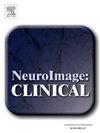神经退行性疾病伴癫痫的海马和杏仁核体积和形态
IF 3.6
2区 医学
Q2 NEUROIMAGING
引用次数: 0
摘要
背景:癫痫在阿尔茨海默病(AD)和非AD性痴呆中很常见。然而,癫痫在痴呆中的神经影像学相关性仍未被探索。我们研究了AD痴呆(AD + Epi)和非AD痴呆(非AD + Epi)伴癫痫的中颞叶形态和体积。方法来自美国39个阿尔茨海默病中心(2005年9月- 2021年12月)的参与者分为伴癫痫痴呆(AD + Epi,非AD + Epi)、无癫痫痴呆(AD-Epi,非AD-Epi);健康对照。根据年龄、性别和痴呆类型(AD与非AD),将有可用核磁共振成像的癫痫痴呆参与者与无癫痫痴呆和健康对照进行匹配。FreeSurfer分节海马和杏仁体。通过ShapeWorks创建的点分布模型量化了左右海马体和杏仁核的形态差异。海马和杏仁体体积归一化为颅内总体积。协变量的多变量分析(MANCOVA),调整了年龄、性别、颅内容积和痴呆严重程度,确定了具有统计学意义的局部形态学和标准化容积组差异。结果共纳入703例,平均年龄70.78岁,其中女性391例,占55.62%。AD-Epi和非AD-Epi均表现出海马和杏仁核的双侧形态萎缩。相比之下,AD + Epi在双侧海马体和尾部表现出形态萎缩,海马头部保留,内侧和外侧表面向内偏移更明显,双侧海马体中部上表面向外偏移更明显。NonAD + Epi在右侧海马头部、尾部和杏仁核中表现出明显的形态学萎缩。各组间无体积差异。结论AD + Epi组海马体、尾萎缩,非AD + Epi组海马右侧头、尾、杏仁核萎缩。不同的侧边和区域特异性的边缘萎缩和畸形模式突出了病理生理上的潜在差异,以及癫痫在阿尔茨海默病和非阿尔茨海默病中改变神经退行性变轨迹的可能作用。本文章由计算机程序翻译,如有差异,请以英文原文为准。

Hippocampus and amygdala volume and morphology in neurodegenerative disorders with co-morbid epilepsy
Background
Epilepsy is common in Alzheimer’s disease (AD) and non-AD dementias. However, the neuroimaging correlates of epilepsy in dementias remain unexplored. We investigated mesial temporal morphology and volumes in AD (AD + Epi) and nonAD dementias (nonAD + Epi) with epilepsy.
Methods
Participants from 39 US Alzheimer’s disease centers (9/2005–12/2021) were classified into dementia with epilepsy (AD + Epi, nonAD + Epi), dementia without epilepsy (AD-Epi, nonAD-Epi); and healthy controls. Dementia with epilepsy participants with available MRIs were matched to dementia without epilepsy and healthy controls by age, sex, and dementia type (AD versus non-AD).
FreeSurfer segmented hippocampi and amygdalae. Point distribution models created via ShapeWorks quantified morphological differences in the left and right hippocampi and amygdalae. Hippocampal and amygdalar volumes were normalized to the total intracranial volume. Multivariate analysis of covariates (MANCOVA), adjusted for age, sex, intracranial volume, and dementia severity, identified statistically significant local morphological and normalized volume group differences.
Result
A total of 703 participants (average age: 70.78 years, 391 (55.62 %) female) were included. AD-Epi and NonAD-Epi exhibited uniform hippocampal and amygdalar morphological atrophy bilaterally. In contrast, AD + Epi demonstrated morphological atrophy in the hippocampal bodies and tails bilaterally with sparing of the hippocampal heads, more pronounced inward deviations on mesial and lateral surfaces, and outward deviations in the middle hippocampal body bilaterally on the superior surface. NonAD + Epi showed significant morphological atrophy in the right hippocampal head, tail, and amygdala. No group volume differences were found.
Conclusion
We identified hippocampal body and tail atrophy in AD + Epi and right hippocampal head, tail, and amygdalar atrophy in nonAD + Epi. Different lateralized and region-specific patterns of limbic atrophy and dysmorphia highlight potential differences in the pathophysiology and the possible role of epilepsy in altering the trajectory of neurodegeneration in AD and nonAD.
求助全文
通过发布文献求助,成功后即可免费获取论文全文。
去求助
来源期刊

Neuroimage-Clinical
NEUROIMAGING-
CiteScore
7.50
自引率
4.80%
发文量
368
审稿时长
52 days
期刊介绍:
NeuroImage: Clinical, a journal of diseases, disorders and syndromes involving the Nervous System, provides a vehicle for communicating important advances in the study of abnormal structure-function relationships of the human nervous system based on imaging.
The focus of NeuroImage: Clinical is on defining changes to the brain associated with primary neurologic and psychiatric diseases and disorders of the nervous system as well as behavioral syndromes and developmental conditions. The main criterion for judging papers is the extent of scientific advancement in the understanding of the pathophysiologic mechanisms of diseases and disorders, in identification of functional models that link clinical signs and symptoms with brain function and in the creation of image based tools applicable to a broad range of clinical needs including diagnosis, monitoring and tracking of illness, predicting therapeutic response and development of new treatments. Papers dealing with structure and function in animal models will also be considered if they reveal mechanisms that can be readily translated to human conditions.
 求助内容:
求助内容: 应助结果提醒方式:
应助结果提醒方式:


